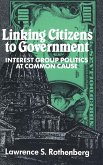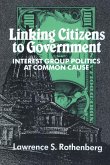- Gebundenes Buch
- Merkliste
- Auf die Merkliste
- Bewerten Bewerten
- Teilen
- Produkt teilen
- Produkterinnerung
- Produkterinnerung
Linking Citizens and Parties highlights the pathways through which citizens' political preferences are expressed by their political parties.
Andere Kunden interessierten sich auch für
![Linking Citizens to Government Linking Citizens to Government]() Lawrence S. RothenbergLinking Citizens to Government93,99 €
Lawrence S. RothenbergLinking Citizens to Government93,99 €![Linking Citizens to Government Linking Citizens to Government]() Lawrence S. RothenbergLinking Citizens to Government39,99 €
Lawrence S. RothenbergLinking Citizens to Government39,99 €![Linking Trade and Security Linking Trade and Security]() Linking Trade and Security76,99 €
Linking Trade and Security76,99 €![Linking Trade and Security Linking Trade and Security]() Linking Trade and Security76,99 €
Linking Trade and Security76,99 €![Linking Political Violence and Crime in Latin America Linking Political Violence and Crime in Latin America]() Linking Political Violence and Crime in Latin America107,99 €
Linking Political Violence and Crime in Latin America107,99 €![Linking Strategic Gains to the 'Responsibility to Protect' (R2P) doctrine Linking Strategic Gains to the 'Responsibility to Protect' (R2P) doctrine]() Joe MajerusLinking Strategic Gains to the 'Responsibility to Protect' (R2P) doctrine17,95 €
Joe MajerusLinking Strategic Gains to the 'Responsibility to Protect' (R2P) doctrine17,95 €![Linking of Emissions Trading Schemes Linking of Emissions Trading Schemes]() Matthias MachinekLinking of Emissions Trading Schemes96,29 €
Matthias MachinekLinking of Emissions Trading Schemes96,29 €-
-
-
Linking Citizens and Parties highlights the pathways through which citizens' political preferences are expressed by their political parties.
Produktdetails
- Produktdetails
- Verlag: OUP Oxford
- Seitenzahl: 202
- Erscheinungstermin: 27. Mai 2010
- Englisch
- Abmessung: 240mm x 161mm x 16mm
- Gewicht: 473g
- ISBN-13: 9780199572526
- ISBN-10: 0199572526
- Artikelnr.: 47870240
- Herstellerkennzeichnung
- Libri GmbH
- Europaallee 1
- 36244 Bad Hersfeld
- gpsr@libri.de
- Verlag: OUP Oxford
- Seitenzahl: 202
- Erscheinungstermin: 27. Mai 2010
- Englisch
- Abmessung: 240mm x 161mm x 16mm
- Gewicht: 473g
- ISBN-13: 9780199572526
- ISBN-10: 0199572526
- Artikelnr.: 47870240
- Herstellerkennzeichnung
- Libri GmbH
- Europaallee 1
- 36244 Bad Hersfeld
- gpsr@libri.de
Lawrence Ezrow is a Lecturer in European Politics in the Department of Government at the University of Essex. His research is on comparative political representation, Western European politics, elections, political parties, voting, party strategies, political institutions, and quantitative methodologies. His articles have appeared in the American Journal of Political Science, British Journal of Political Science, European Journal of Political Research, and Journal of Politics.
* List of tables and figures
* Preface and Acknowledgements
* Part I Introduction
* Citizen-Party Linkages, Political Institutions, and Types of Party
* Part II Similarities across Democracies
* 2: Are Moderate Parties Rewarded in Multiparty Systems?
* 3: Parties' Policy Programmes and the Dog that Didn't Bark: No
Evidence that Proportional Systems Promote Extreme Party Positioning
* Part III: Effects of Electoral Institutions
* 4: Electoral Rules, the Number of Parties, and Niche Party Success
* 5: Proximity and Votes for Mainstream and Niche Parties
* 6: Mean Voter Representation versus Partisan Constituency
Representation: Do Parties Respond to the Mean Voter Position or to
their Supporters?
* Part IV: Conclusion
* 7: The Effects of Electoral Institutions
* Appendix
* References
* Index
* Preface and Acknowledgements
* Part I Introduction
* Citizen-Party Linkages, Political Institutions, and Types of Party
* Part II Similarities across Democracies
* 2: Are Moderate Parties Rewarded in Multiparty Systems?
* 3: Parties' Policy Programmes and the Dog that Didn't Bark: No
Evidence that Proportional Systems Promote Extreme Party Positioning
* Part III: Effects of Electoral Institutions
* 4: Electoral Rules, the Number of Parties, and Niche Party Success
* 5: Proximity and Votes for Mainstream and Niche Parties
* 6: Mean Voter Representation versus Partisan Constituency
Representation: Do Parties Respond to the Mean Voter Position or to
their Supporters?
* Part IV: Conclusion
* 7: The Effects of Electoral Institutions
* Appendix
* References
* Index
* List of tables and figures
* Preface and Acknowledgements
* Part I Introduction
* Citizen-Party Linkages, Political Institutions, and Types of Party
* Part II Similarities across Democracies
* 2: Are Moderate Parties Rewarded in Multiparty Systems?
* 3: Parties' Policy Programmes and the Dog that Didn't Bark: No
Evidence that Proportional Systems Promote Extreme Party Positioning
* Part III: Effects of Electoral Institutions
* 4: Electoral Rules, the Number of Parties, and Niche Party Success
* 5: Proximity and Votes for Mainstream and Niche Parties
* 6: Mean Voter Representation versus Partisan Constituency
Representation: Do Parties Respond to the Mean Voter Position or to
their Supporters?
* Part IV: Conclusion
* 7: The Effects of Electoral Institutions
* Appendix
* References
* Index
* Preface and Acknowledgements
* Part I Introduction
* Citizen-Party Linkages, Political Institutions, and Types of Party
* Part II Similarities across Democracies
* 2: Are Moderate Parties Rewarded in Multiparty Systems?
* 3: Parties' Policy Programmes and the Dog that Didn't Bark: No
Evidence that Proportional Systems Promote Extreme Party Positioning
* Part III: Effects of Electoral Institutions
* 4: Electoral Rules, the Number of Parties, and Niche Party Success
* 5: Proximity and Votes for Mainstream and Niche Parties
* 6: Mean Voter Representation versus Partisan Constituency
Representation: Do Parties Respond to the Mean Voter Position or to
their Supporters?
* Part IV: Conclusion
* 7: The Effects of Electoral Institutions
* Appendix
* References
* Index









